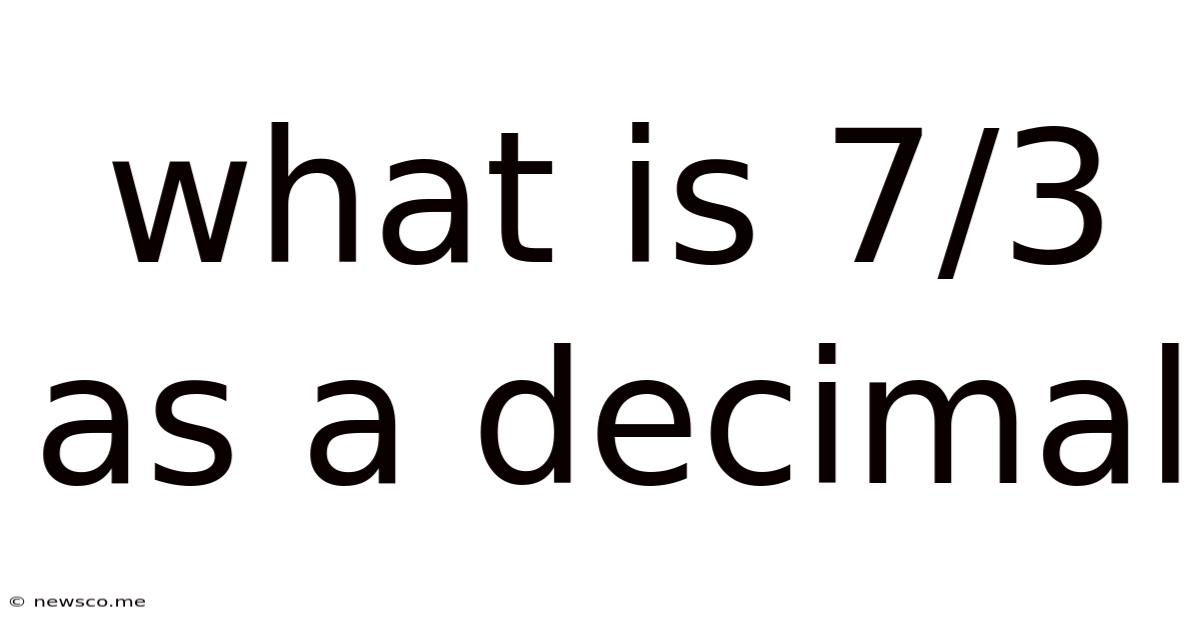What Is 7/3 As A Decimal
News Co
May 08, 2025 · 4 min read

Table of Contents
What is 7/3 as a Decimal? A Comprehensive Guide
The seemingly simple question, "What is 7/3 as a decimal?", opens the door to a fascinating exploration of fractions, decimals, and the fundamental relationship between them. While a quick calculation might provide the answer, a deeper dive reveals valuable insights into mathematical concepts and practical applications. This comprehensive guide will not only answer the question but also equip you with a solid understanding of the underlying principles.
Understanding Fractions and Decimals
Before diving into the conversion of 7/3, let's solidify our understanding of fractions and decimals.
Fractions: A fraction represents a part of a whole. It consists of two parts: the numerator (the top number) and the denominator (the bottom number). The numerator indicates how many parts we have, while the denominator indicates how many parts make up the whole. For example, in the fraction 7/3, 7 is the numerator and 3 is the denominator. This means we have 7 parts of a whole that's divided into 3 equal parts.
Decimals: A decimal is a way of representing a number using a base-10 system. It uses a decimal point to separate the whole number part from the fractional part. The digits to the right of the decimal point represent tenths, hundredths, thousandths, and so on. For instance, 0.5 represents five-tenths (5/10), and 0.75 represents seventy-five hundredths (75/100).
Converting 7/3 to a Decimal: The Method
Converting a fraction to a decimal involves dividing the numerator by the denominator. In the case of 7/3, we perform the division: 7 ÷ 3.
This division results in a repeating decimal. Let's perform the long division:
2.333...
3 | 7.000
-6
---
10
-9
---
10
-9
---
10
-9
---
1... and so on.
As you can see, the remainder is always 1, resulting in an infinitely repeating sequence of 3s. We represent this repeating decimal using a bar over the repeating digit(s): 2.3̅. This notation indicates that the digit 3 repeats infinitely.
Why is it a Repeating Decimal?
Not all fractions convert to terminating decimals (decimals that end). A fraction will produce a repeating decimal if its denominator, when simplified to its lowest terms, contains prime factors other than 2 and 5. Since the denominator of 7/3 (when simplified) is 3, a prime number other than 2 or 5, the resulting decimal is a repeating decimal.
Practical Applications and Real-World Examples
Understanding the conversion of fractions to decimals is crucial in various real-world applications:
-
Measurement: Imagine measuring ingredients for a recipe. If a recipe calls for 7/3 cups of flour, you would need to convert it to a decimal (2.33 cups) for easier measurement using a standard measuring cup.
-
Finance: Calculations involving money often require decimal representation. For example, dividing profits among 3 partners based on shares represented by fractions would involve converting those fractions to decimals.
-
Engineering and Construction: Accurate measurements and calculations are paramount in engineering and construction. Converting fractions to decimals ensures precise calculations.
-
Data Analysis: When working with datasets, you often encounter fractions that need to be converted to decimals for statistical analysis and representation in graphs and charts.
Beyond 7/3: Exploring Other Fraction-to-Decimal Conversions
The process of converting fractions to decimals remains consistent regardless of the numbers involved. Let's explore a few more examples:
-
1/4: 1 ÷ 4 = 0.25 (terminating decimal)
-
5/8: 5 ÷ 8 = 0.625 (terminating decimal)
-
2/3: 2 ÷ 3 = 0.6̅ (repeating decimal)
-
1/7: 1 ÷ 7 = 0.142857̅ (repeating decimal with a longer repeating sequence)
These examples illustrate the diversity in the outcomes of fraction-to-decimal conversions. Some result in terminating decimals, while others yield repeating decimals with varying lengths of repeating sequences.
Advanced Concepts: Rational and Irrational Numbers
The conversion of fractions to decimals also touches upon the broader mathematical concepts of rational and irrational numbers.
-
Rational Numbers: Rational numbers are numbers that can be expressed as a fraction of two integers (where the denominator is not zero). All fractions, whether they convert to terminating or repeating decimals, are rational numbers.
-
Irrational Numbers: Irrational numbers cannot be expressed as a fraction of two integers. They have non-repeating, non-terminating decimal expansions. Famous examples include π (pi) and √2 (the square root of 2).
Using Technology for Conversion
While manual calculation provides a deeper understanding, technology offers efficient tools for converting fractions to decimals. Calculators, spreadsheets, and various mathematical software packages can readily perform this conversion. However, understanding the underlying principles remains invaluable, ensuring you can interpret the results accurately and troubleshoot any issues that might arise.
Conclusion: Mastering Fraction-to-Decimal Conversions
The seemingly simple conversion of 7/3 to its decimal equivalent, 2.3̅, unlocks a gateway to a broader understanding of fractions, decimals, rational numbers, and the fundamental principles of mathematics. By mastering this conversion and understanding the underlying concepts, you equip yourself with a powerful tool applicable across various disciplines and real-world scenarios. Remember, the ability to perform this conversion is not just about getting the answer; it's about developing a deeper appreciation for the beauty and elegance of mathematics. The journey from fraction to decimal is a testament to the interconnectedness of mathematical concepts and their practical relevance.
Latest Posts
Related Post
Thank you for visiting our website which covers about What Is 7/3 As A Decimal . We hope the information provided has been useful to you. Feel free to contact us if you have any questions or need further assistance. See you next time and don't miss to bookmark.